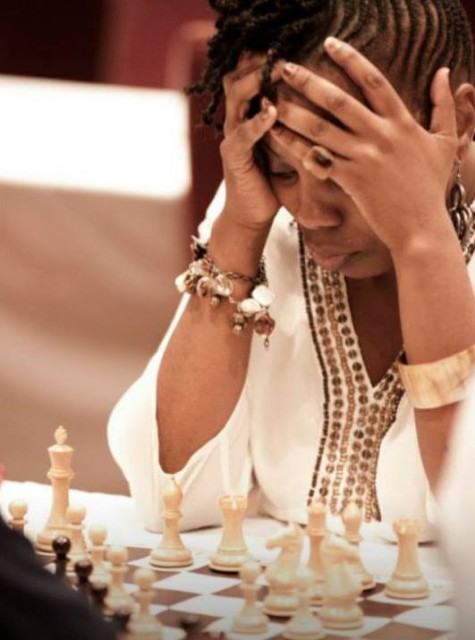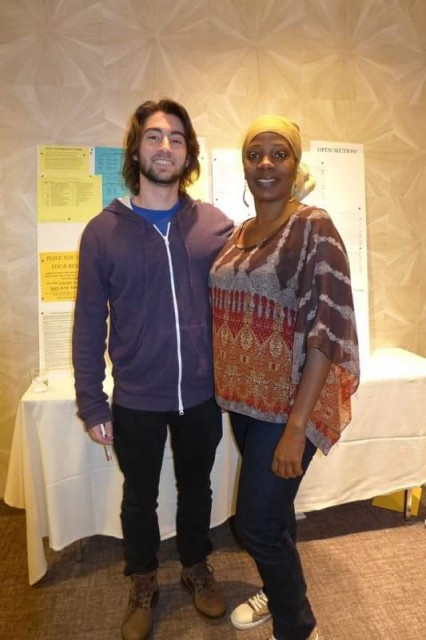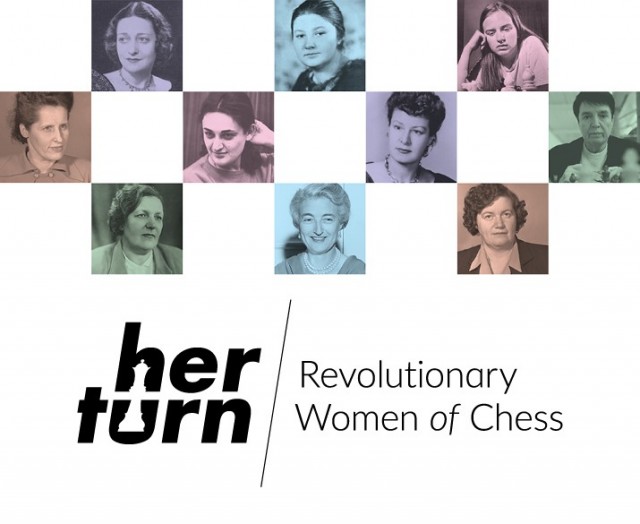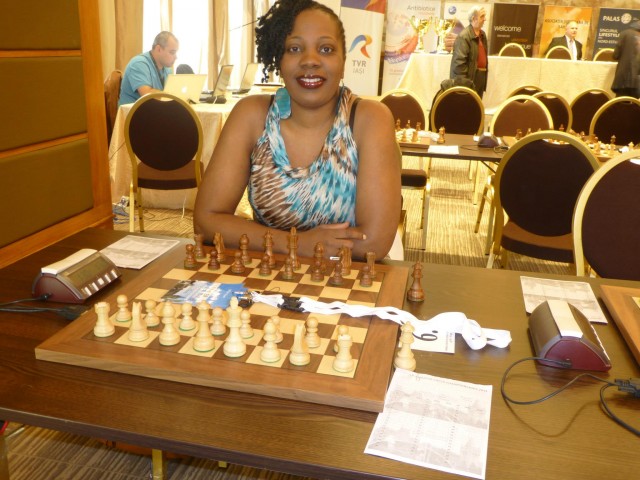
For Adia Onyango, the way to get better at chess — and in other areas of life — is through challenges.
So late last year, the chess instructor from Brooklyn, New York challenged herself to play four major tournaments in 40 days.
The arduous challenge led her to compete in the North American Open in Las Vegas during the last week of 2015; followed by the Boston Chess Congress; the Liberty Bell Open in Philadelphia, and the Baltimore Open, all of which took place in January.
“I just wanted a little boost to start the year and motivate myself for 2016 to see how I would fare trying to do so many major tournaments within a short span of time,” Onyango said. “I just feel for myself that (a challenge) is a great motivator for kind of keeping up the energy.”
Despite subjecting herself to a whirlwind itinerary of back-to-back tournaments, Onyango emerged victorious in every single one.
Not only did she score money prizes in the Under 1900 section of three out of four tournaments, but Oyango also won mixed doubles prizes in all three of the tournaments in which they were offered.
The results confirmed her belief that hard work, studying, eating right and staying physically fit all have their rewards.
“I was happy with the consistency,” Onyango said, although she added that she had hoped to do even better.
Here’s a breakdown of Onyango’s latest winning streak:
- Tied for second in the North American Open with 5.5 out of 7 points in the Under 1900 section, netting a prize of $564.
- Also tied for first in the mixed doubles section of the North American Open, splitting an additional $846.75 with James Canty III, of Michigan.
- Then, in Boston, split another $425 with Ryan Mark Wantroba, of Connecticut, after the pair tied for second in the mixed doubles competition. Onyango had scored 3.5 out of 5 points in the Under 1900 section.
- Tied for second with 5.5 out of 6 points in the Under 1900 Section at the Liberty Bell Open, picking up another $511.
- Also split $1022 after winning first place in the mixed doubles prize with IM Alexander Ostrovskiy. of New York.
- Tied for first by scoring 4 out of 5 points in the Under 1900 section of the Baltimore Open, picking up another $362.50.
 Adia with IM Alexander Ostrovskiy
Adia with IM Alexander Ostrovskiy
The prizes brought her grand total of winnings to just over $3000 although, of course, one would have to deduct travel and lodging to get a better perspective on the payoff.
Irrespective of whether her winnings represented a net financial gain, for Onyango it’s not about the prizes — it’s about putting yourself to the test and be able to endure.
“The best test is actually going out and seeing how you’re doing,” said Onyango, who is likely to find herself in the Top 100 female players in the US as a result of her recent wins, which pushed her rating up to 1960. That’s just eight points shy of her peak rating of 1968, USCF records show.
Onyango is no stranger to challenges. She routinely gives herself a series of personal challenges that have included a bike challenge (she bikes at least 15 miles per day every day, even during the winter). On the dietary side of things, she regularly adheres to a “green smoothie challenge,” where she consumes at least one green smoothie per day — often in place of a meal — to ensure she gets her proper intake of fruits and vegetables — namely, green apples, kale and spinach.

In fact, Onyango often relies on green smoothies during tournaments. She typically brings a Nutribullet miniature blender with her to tournaments so that she can keep up her green smoothie routine even when she is on the move.
“Which has been a great thing because, as you know, we play five hour games, and after the second hour or so you start to get hungry,” Onyango said.
Onyango says the various challenges she gave to herself began as a way to prepare for the first Millionaire Chess Open in 2014.
“I decided if I was going to pay a one-thousand dollar entry fee for a tournament, then I really need to start to own the things I say I feel are important, which are fitness and nutrition in addition to studying chess, and so at that point I started these challenges,” Onyango said.
Onyango is a big fan of the mixed doubles prizes, which seem to be becoming more commonplace.
“I think mixed double prizes is a great thing that’s being created,” Onyango said. “I think it really has increased some of the interaction between men and women on and off the chessboard.”
But as far as being a mixed doubles partner with Onyango, male players should not expect her to agree just because they asked nicely.
When it comes to picking a partner, Onyango — as this writer knows from firsthand experience — is rather selective, which is perhaps one of the rare advantages associated with the fact that, globally, male players outnumber female players by a ratio of about
12 to 1.
“I look for someone that might do well,” Onyango said. “Sometimes, it’s just the luck of the draw.”
Onyango wouldn’t reveal exactly what kind of formula she uses to pick a mixed doubles partner, but it is evidently rooted in some sort of numerical analysis.
“I’m frequently one who looks at facts and figures. That’s part of my DNA,” Onyango said. “I don’t just ignore numbers.”
Asked what her next challenge would be in the area of chess, Onyango said she hopes to “break the expert barrier” before the end of the year.
“Hopefully it can happen at the
Millionaire Open in 2016,” she said.
Onyango also hopes to play at the
Mid-America Open in St. Louis, but she admitted she has another motive for wanting to visit St. Louis.
“I want to do so more because I want to see the new exhibit on women in chess,” Onyango said in reference to the exhibit at the World Chess Hall of Fame.
The latest such exhibit is called
"Her Turn: Revolutionary Women of Chess." The exhibit launched this month and runs through September 4. Another exhibit, titled
"Ladies Knight: A Female Perspective on Chess," runs through May 1, so for a short while, visitors will be able to see both exhibits that feature women in chess.

As a world traveller, Onyango also wants to challenge herself to play in at least one tournament abroad.
“This year hopefully I’ll play in Italy or Paris,” she said.
[pgn]
[Event "4th Boston Chess Congress"]
[Site "Boston"]
[Date "2016. 01.09"]
[Round "?"]
[White "Onyango, Adia"]
[Black "Dusza, Richard"]
[Result "1-0"]
[PlyCount "91"]
{ I named this game "Frozen" because you will see
that eventually all of black's pieces become frozen, even his king!} 1. d4 d5
2. c4 e6 3. Nc3 c6 4. Nf3 Nf6 5. Bf4 Be7 6. e3 Nbd7 7. c5 Ne4 8. Qc2 Nxc3 9.
Qxc3 h6 10. Bd3 Bf6 11. Bd6 Be7 12. Bg3 {White steals a move from Black.} Bf6
13. O-O O-O 14. b4 a5 15. b5 a4 16. b6 a3 {Black has made the a-pawn very weak
and now white simply has to be patient and pile on this weakness!} 17. Rab1 g6
18. Rb3 Kg7 19. Rxa3 Rxa3 20. Qxa3 g5 21. Qb4 g4 22. Ne5 {Here I made the
decision to proceed forward instead of backwards because if black captured it
would allow my Queen to inflitrate the Kingside after dxe5 instead of Be5. The
tradeoff would be that my e-pawn would now be blocking my Bishop, however I
thought that this was worth it given the few number of pieces around blacks
king, all of the weak squares on Blacks kingside, and the open 4th rank.} Bxe5
23. dxe5 f5 24. exf6+ Qxf6 25. Qxg4+ {A two pawn advantage, the bishop pair
and active pieces make white very happy about this position.} Kh8 26. Qh5 {
White tries to play actively, daring black to take the unprotected c5 pawn.} e5
27. Bg6 Qg5 28. h4 Qxh5 29. Bxh5 {Notice Black still can not take the c5 pawn
due to Bxe5+, followed by Bd6.} Kg7 30. Bg4 Kf6 31. Rc1 {Here Black has what
looks like a beautiful discovered attack where the Knight can rubberband back
and protect the Bishop. However, the one drawback to this move is that it
allows white to trade off pieces while still maintaining a material advantage.
Additionally, by capturing the b6 pawn white will be able to apply pressure
along the b-file and 4th rank and potentially keep black's pieces tied up for
several moves, trying to protect the weak backwards pawn and develop his
knight.} Nxb6 32. Bxc8 Nxc8 33. Rb1 Rf7 {Notice that Black's pieces do not
have many squares to go to. If Na7 than a4!} 34. Rb4 Rd7 35. h5 {taking away
squares from the king} e4 36. Bf4 Kg7 37. Be5+ {Taking away more squares from
the king and placing the Bishop on the optimal diagonal.} Kh7 38. f3 Re7 39.
Bf4 exf3 40. gxf3 Rf7 41. Kf2 Rd7 42. Be5 Ne7 43. Rf4 {Restricting the knight}
Ng8 44. Rf8 {Notice that the only move black has that does not lose material
is Rd7-e7-d7, most of black's pieces are frozen!} Re7 45. f4 Rd7 46. f5 {At
this point black resigned due to the impending doom after 47...Re7 48. Bd4 Rd7
49. f6! and now the rook can not even go to e7 anymore, it is frozen as well.
Any move here for black will lose mateial and untimately the game.} 1-0[/pgn]

 For Adia Onyango, the way to get better at chess — and in other areas of life — is through challenges.
So late last year, the chess instructor from Brooklyn, New York challenged herself to play four major tournaments in 40 days.
The arduous challenge led her to compete in the North American Open in Las Vegas during the last week of 2015; followed by the Boston Chess Congress; the Liberty Bell Open in Philadelphia, and the Baltimore Open, all of which took place in January.
“I just wanted a little boost to start the year and motivate myself for 2016 to see how I would fare trying to do so many major tournaments within a short span of time,” Onyango said. “I just feel for myself that (a challenge) is a great motivator for kind of keeping up the energy.”
Despite subjecting herself to a whirlwind itinerary of back-to-back tournaments, Onyango emerged victorious in every single one.
Not only did she score money prizes in the Under 1900 section of three out of four tournaments, but Oyango also won mixed doubles prizes in all three of the tournaments in which they were offered.
The results confirmed her belief that hard work, studying, eating right and staying physically fit all have their rewards.
“I was happy with the consistency,” Onyango said, although she added that she had hoped to do even better.
Here’s a breakdown of Onyango’s latest winning streak:
For Adia Onyango, the way to get better at chess — and in other areas of life — is through challenges.
So late last year, the chess instructor from Brooklyn, New York challenged herself to play four major tournaments in 40 days.
The arduous challenge led her to compete in the North American Open in Las Vegas during the last week of 2015; followed by the Boston Chess Congress; the Liberty Bell Open in Philadelphia, and the Baltimore Open, all of which took place in January.
“I just wanted a little boost to start the year and motivate myself for 2016 to see how I would fare trying to do so many major tournaments within a short span of time,” Onyango said. “I just feel for myself that (a challenge) is a great motivator for kind of keeping up the energy.”
Despite subjecting herself to a whirlwind itinerary of back-to-back tournaments, Onyango emerged victorious in every single one.
Not only did she score money prizes in the Under 1900 section of three out of four tournaments, but Oyango also won mixed doubles prizes in all three of the tournaments in which they were offered.
The results confirmed her belief that hard work, studying, eating right and staying physically fit all have their rewards.
“I was happy with the consistency,” Onyango said, although she added that she had hoped to do even better.
Here’s a breakdown of Onyango’s latest winning streak:
 Adia with IM Alexander Ostrovskiy
Adia with IM Alexander Ostrovskiy In fact, Onyango often relies on green smoothies during tournaments. She typically brings a Nutribullet miniature blender with her to tournaments so that she can keep up her green smoothie routine even when she is on the move.
“Which has been a great thing because, as you know, we play five hour games, and after the second hour or so you start to get hungry,” Onyango said.
Onyango says the various challenges she gave to herself began as a way to prepare for the first Millionaire Chess Open in 2014.
“I decided if I was going to pay a one-thousand dollar entry fee for a tournament, then I really need to start to own the things I say I feel are important, which are fitness and nutrition in addition to studying chess, and so at that point I started these challenges,” Onyango said.
Onyango is a big fan of the mixed doubles prizes, which seem to be becoming more commonplace.
“I think mixed double prizes is a great thing that’s being created,” Onyango said. “I think it really has increased some of the interaction between men and women on and off the chessboard.”
But as far as being a mixed doubles partner with Onyango, male players should not expect her to agree just because they asked nicely.
When it comes to picking a partner, Onyango — as this writer knows from firsthand experience — is rather selective, which is perhaps one of the rare advantages associated with the fact that, globally, male players outnumber female players by a ratio of about 12 to 1.
“I look for someone that might do well,” Onyango said. “Sometimes, it’s just the luck of the draw.”
Onyango wouldn’t reveal exactly what kind of formula she uses to pick a mixed doubles partner, but it is evidently rooted in some sort of numerical analysis.
“I’m frequently one who looks at facts and figures. That’s part of my DNA,” Onyango said. “I don’t just ignore numbers.”
Asked what her next challenge would be in the area of chess, Onyango said she hopes to “break the expert barrier” before the end of the year.
“Hopefully it can happen at the Millionaire Open in 2016,” she said.
Onyango also hopes to play at the Mid-America Open in St. Louis, but she admitted she has another motive for wanting to visit St. Louis.
“I want to do so more because I want to see the new exhibit on women in chess,” Onyango said in reference to the exhibit at the World Chess Hall of Fame.
The latest such exhibit is called "Her Turn: Revolutionary Women of Chess." The exhibit launched this month and runs through September 4. Another exhibit, titled "Ladies Knight: A Female Perspective on Chess," runs through May 1, so for a short while, visitors will be able to see both exhibits that feature women in chess.
In fact, Onyango often relies on green smoothies during tournaments. She typically brings a Nutribullet miniature blender with her to tournaments so that she can keep up her green smoothie routine even when she is on the move.
“Which has been a great thing because, as you know, we play five hour games, and after the second hour or so you start to get hungry,” Onyango said.
Onyango says the various challenges she gave to herself began as a way to prepare for the first Millionaire Chess Open in 2014.
“I decided if I was going to pay a one-thousand dollar entry fee for a tournament, then I really need to start to own the things I say I feel are important, which are fitness and nutrition in addition to studying chess, and so at that point I started these challenges,” Onyango said.
Onyango is a big fan of the mixed doubles prizes, which seem to be becoming more commonplace.
“I think mixed double prizes is a great thing that’s being created,” Onyango said. “I think it really has increased some of the interaction between men and women on and off the chessboard.”
But as far as being a mixed doubles partner with Onyango, male players should not expect her to agree just because they asked nicely.
When it comes to picking a partner, Onyango — as this writer knows from firsthand experience — is rather selective, which is perhaps one of the rare advantages associated with the fact that, globally, male players outnumber female players by a ratio of about 12 to 1.
“I look for someone that might do well,” Onyango said. “Sometimes, it’s just the luck of the draw.”
Onyango wouldn’t reveal exactly what kind of formula she uses to pick a mixed doubles partner, but it is evidently rooted in some sort of numerical analysis.
“I’m frequently one who looks at facts and figures. That’s part of my DNA,” Onyango said. “I don’t just ignore numbers.”
Asked what her next challenge would be in the area of chess, Onyango said she hopes to “break the expert barrier” before the end of the year.
“Hopefully it can happen at the Millionaire Open in 2016,” she said.
Onyango also hopes to play at the Mid-America Open in St. Louis, but she admitted she has another motive for wanting to visit St. Louis.
“I want to do so more because I want to see the new exhibit on women in chess,” Onyango said in reference to the exhibit at the World Chess Hall of Fame.
The latest such exhibit is called "Her Turn: Revolutionary Women of Chess." The exhibit launched this month and runs through September 4. Another exhibit, titled "Ladies Knight: A Female Perspective on Chess," runs through May 1, so for a short while, visitors will be able to see both exhibits that feature women in chess.
 As a world traveller, Onyango also wants to challenge herself to play in at least one tournament abroad.
“This year hopefully I’ll play in Italy or Paris,” she said.
As a world traveller, Onyango also wants to challenge herself to play in at least one tournament abroad.
“This year hopefully I’ll play in Italy or Paris,” she said.








